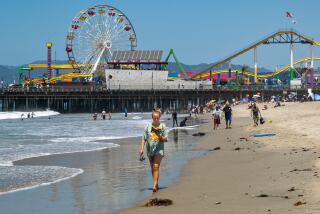Photographerâs Show Presents a Dirty Picture : Pollution: Mark Greenberg hopes photos showing storm drain runoff will revive concern about contamination of Santa Monica Bay.
The photograph shows children building sandcastles in ankle-deep water. In the background, two boys play catch with a beach ball. It is a lazy, sun-drenched scene, the stuff of which childhood memories are made.
Bad memories, perhaps.
The wet playground in the photo is actually the runoff from the Pico-Kenter storm drain in Santa Monica, where water tainted by pesticides, toxic metals, animal waste and other contaminants empties into Santa Monica Bay. Pollution there is so bad that swimming is banned.
Those facts appear to be lost on the children in the photo but certainly not on Santa Monica photographer Mark Greenberg. In an exhibition at West Hollywood City Hall, Greenberg documents the devastation at a handful of the most polluted outlets along the Los Angeles County coastline. Although the problems associated with the storm drains are not new, Greenberg hopes to again rivet the publicâs attention on the subject.
âI want people to be aware that we are losing our bay,â Greenberg, 37, said during the exhibitionâs recent opening. âThe more who see this work, the more who may think twice before throwing that Styrofoam cup into the street.â
Urban runoff is carried into the bay by 60 storm drains. Those in the South Bay include one near Imperial Highway in Playa del Rey, another at Herondo Street in Redondo Beach and a third at Avenue I in Redondo Beach.
Greenbergâs 22 black-and-white photos, collectively titled âProject Storm Drain,â depict a bleak landscape, for the most part void of living things. There is the dead sea gull, oily feathers crushed against charcoal-colored sand. And the oozing gray muck wrapped around a twisted Big Mac container and a mangled Budweiser can.
For Robert Ebendorf, a Santa Monica sculptor who attended the opening, the photos are a social commentary, and raise the question of how to cope with the problem.
âThe photos imprint a powerful visual message about the filth on our beaches,â Ebendorf said, pointing to a half-filled whiskey bottle in one shot. âThey are a valuable collection for those who will look back on us 100 years from now and ask what we did about it.â
The photos have also elicited reactions laced with cynicism.
âGarbage has become so much a part of our consciousness that we donât even notice it anymore,â said Stephen White, a Brentwood photo collector and former gallery owner. âThe fact that people let their children play in this is frightening.â
The exhibition comes amid new warnings over the dangers posed by the runoff. The group overseeing the cleanup of the bay, the Santa Monica Restoration Project, recently advised swimmers to stay at least 100 yards away from the outlets. Research by the environmental group Heal the Bay found high concentrations of bacterial pollution and human viruses, indicating the existence of sewage in the water, according to Mark Gold, the groupâs staff scientist.
Other studies have found high levels of toxic metals, including lead, zinc and cadmium, as well as traces of automotive oil and grease. Environmentalists estimate that the 60 storm drains dump 25 million gallons of runoff into the bay daily.
The pollution has created an uproar among environmental groups in recent years and prompted local officials to get tough. In late August, the Santa Monica and Malibu city councils ordered the drafting of ordinances that call for a 20% reduction in runoff from new development. About a year ago, the Los Angeles City Council began taxing homeowners to raise money for improvements to the storm-drain system.
For Greenberg, the West Hollywood exhibition is the first step in publicizing those facts and others. The exhibition is expected to move to Santa Monica City Hall in mid-December.
Greenberg says he is not an environmentalist, just a concerned resident. He stumbled onto the project by accident, while biking with his dog along the beach. During those rides, he began noticing daily changes at three of the outlets--Pico-Kenter at the base of Pico Boulevard, the concrete channel of Ballona Creek at the entrance to Marina del Rey and the Chautauqua drain at the base of Chautauqua Boulevard in Pacific Palisades.
Debris shifted, the color of the sand changed and birds settled in different areas--depending on the water flow. The changes fascinated Greenberg, and he began shooting pictures last November. Sixty rolls of film and 2,000 pictures later, he created a masterâs thesis project at Cal State Los Angeles, which he completed last spring. Not long after, he was able to persuade West Hollywood that the photos would make a powerful exhibition.
âI knew this was something I had to share,â Greenberg said. âPeople had to see what I was seeing. I thought that maybe something could be done politically to expedite the cleanup.â
More to Read
Sign up for Essential California
The most important California stories and recommendations in your inbox every morning.
You may occasionally receive promotional content from the Los Angeles Times.










